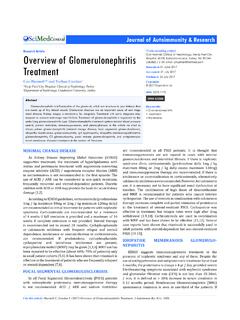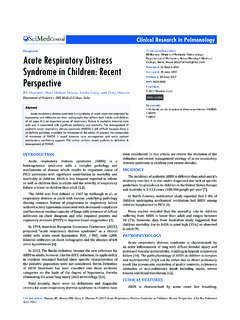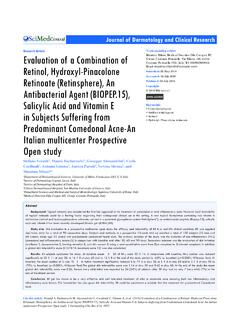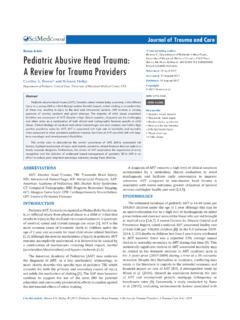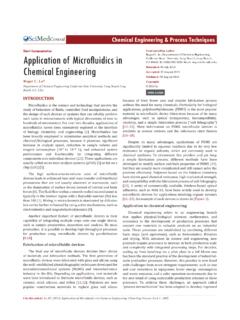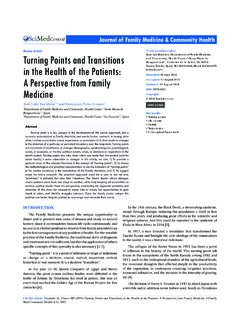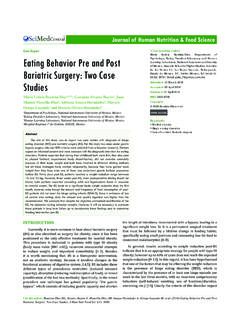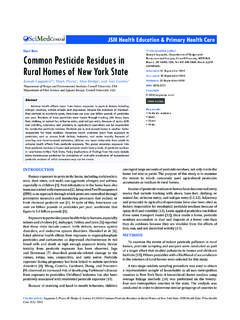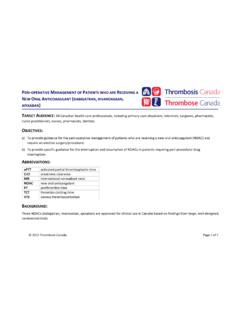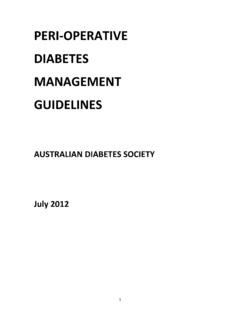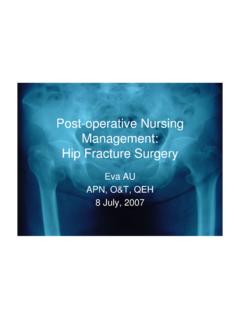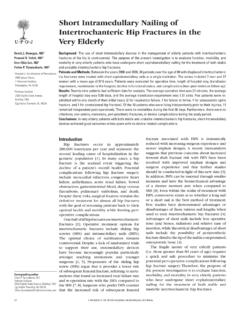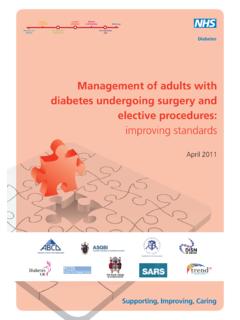Transcription of Peri-Operative Management of the Patient with …
1 Journal of Dermatology and Clinical Research Cite this article: Delaisse J, Varada S, Au SC, Pope A, Manders E, et al. (2014) Peri-Operative Management of the Patient with Body Piercings. J Dermatolog Clin Res 2(1): *Corresponding authorMarigdalia K. Ramirez-Fort, Department of Dermatology, Tufts Medical , 800 Washington St., #114, Boston, MA 02111, Tel: 617-636-1579; Fax: 617-636-9169; E-mail: Submitted: 16 December 2013 Accepted: 08 January 2014 Published: 10 January 2014 Copyright 2014 Ramirez-Fort et al. OPEN ACCESS Keywords Body piercings Body jewelry Piercing removal Perioperative Management SurgeryReview Article Peri-Operative Management of the Patient with Body PiercingsJessica Delaisse BA1, Sowmya Varada BS2, Shiu-Chung Au , Adam Pope2, Ernest Manders and Marigdalia K.
2 Ramirez-Fort *1 Department of Dermatology, The University of Texas Medical Branch, USA2 Department of Plastic and Reconstructive Surgery, Tufts Medical Center, USA3 University of Pittsburgh Medical Center, USAA bstractNumbers of complications have been reported as a result of wearing body jewelry during surgical work-up, perioperative Management and during surgical procedures. However, there is a paucity of published data regarding the clinical implications and considerations that physicians should deliberate when encountering the surgical Patient with body piercings. We performed a thorough Medline literature review on August 1, 2013 on the topic of piercings or body piercings and surgery.
3 Although data are minimal, anesthetic and surgical complications secondary to body piercings may be prevented by thorough informed consent and pre- operative removal of body jewelry. Knowledge of the techniques used for safe jewelry removal, to maintain patent piercing tracts, and for maintaining a non-judgmental attitude will increase Patient confidence in his or her physician and surgeon. INTRODUCTIONA number of complications have resulted from wearing body jewelry during surgical work-up, perioperative Management , and surgical procedures. Either due to negligence or in an effort to avoid the discomfort and inconvenience of removing and reinserting body piercings, patients often keep body jewelry on during procedures [1,2].
4 As the practice of body piercing becomes more common, it is increasingly important for physicians to understand the associated risks and employ safe methods of removing jewelry and maintaining patency of piercing tracts [1,3].PREOPERATIVE CONSIDERATIONSD iagnostic imagingThe presence of metal body jewelry has been known to interfere with ultrasound, CT, and MRI and cause injury to the Patient during the procedure [2,4,5]. Knowledge of various forms and common locations of body piercing is particularly important during the primary survey of the obtunded trauma Patient who requires diagnostic imaging but is unable to confirm the presence of jewelry.
5 Metal jewelry containing ferric oxide can oscillate during MRI scans, creating kinetic energy that can result in Patient discomfort, burns, or skin punctures [5-7]. All metal jewelry produces artifacts, or metallic shadows, that may interfere with the quality and interpretability of MRI reports. Similarly, during plain radiography, metal jewelry scatters x-rays and leaves artifacts on the diagnostic film, often rendering it unusable [2,4]. Body jewelry should be removed prior to an imaging study to prevent potential physical complications and diagnostic delay, both of which may impede surgical Management . Endotracheal intubationMost preoperative complications caused by body piercings occur during endotracheal intubation [1,3,8-10].
6 The presence of nose, tongue, or lip jewelry can prevent adequate visualization of the airway. Also, the process of intubation may traumatize the piercing, resulting in bleeding, hematoma formation, tongue edema, or pharyngeal edema. Dislodged jewelry can be easily aspirated [3,10]. In one case, a Patient who developed a traumatic post-intubation bleed around a tongue piercing developed complete airway obstruction secondary to laryngeal irritation and laryngospasm [3,8]. Removing oral piercings preoperatively would prevent such complicating events. The oral cavity should also be examined post-operatively to identify trauma from jewelry left in place or to confirm that jewelry has not been lost during the procedure [3].
7 In the case that jewelry has been lost, fiberoptic endoscopy may be utilized for localization and extraction within the nasopharynx, esophagus, larynx, or trachea [3].Urinary catheterizationUrinary catheter insertion, when done without care in the presence of a genital piercing, can create partial or full thickness urethral tears that may require suprapubic cystostomy or primary surgical closure [11,12]. Untreated urethral injuries from manipulation of genital piercings can cause urethral obstruction, scar formation, and urinary flow changes [5,12,13]. To avoid urethral damage, physicians should select a smaller Ramirez-Fort et al. (2014)Email: J Dermatolog Clin Res 2(1): 1009 (2014) 2/4 Centralgauge catheter to bypass the jewelry or advise patients to remove genital piercings beforehand [11,12].
8 SURGICAL CONSIDERATIONSBody jewelry left in place during surgery has been reported to cause burns, pressure-related tissue injury, and infection [1,2]. In cases utilizing electrocautery, body jewelry may conduct the electrical current and cause electrical burns to the surrounding tissue [2]. When patients (particularly those who are overweight or obese) are placed in the prone position for extended periods of time, nipple, navel, and other piercings on the chest and abdomen may cause pressure injury [1]. Jewelry pieces that become loosened or dislodged during surgical procedures may potentially enter the surgical wound and remain inside a body cavity.
9 Removing body jewelry preoperatively or securing it to the body with tape will avert such occurrences. Anterior and lateral radiographs of head, neck, chest, and abdomen may be used to visualize pieces lost within body cavities. Invasive surgical procedures heighten the risk of transient bacteremia, which can seed body piercings and cause a local or systemic infection. A case of sepsis is reported to have resulted from the reinsertion of body jewelry two days after a spinal arthrodesis, when the jewelry was colonized by blood borne bacteria and became a locus of infection [14-18]. Just as the American Heart Association recommends prophylactic antibiotics for patients with prosthetic heart valves undergoing surgical procedures[14,15], practitioners may consider a dose of prophylactic antibiotics for the surgical Patient with extensive body piercings to minimize the risk of piercing site infections [16,17].
10 This phenomenon has also been observed with nipple piercings following breast implantation. One report describes a female Patient who developed cellulitis and subsequent inflammation of her implant from a piercing received after breast augmentation surgery [19]. Another describes a male Patient who similarly pierced his nipples after bilateral breast implants, resulting in infection and eventual explantation [20]. These cases suggest that nipple piercings may be contraindicated during a certain period of time after breast implantation. Organ transplantationTransmission of blood-borne diseases is a potential risk in transplantation of organs from patients with body piercings [21].

